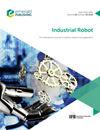一种用于轮式机器人自主路径导航的智能快速控制器
IF 2.5
4区 计算机科学
Q3 ENGINEERING, INDUSTRIAL
Industrial Robot-The International Journal of Robotics Research and Application
Pub Date : 2022-07-07
DOI:10.1108/ir-01-2022-0026
引用次数: 2
摘要
目的结合智能粒子群优化(IPSO)控制器实现未知环境下的最优路径。本文采用智能设计参数设计IPSO适应度函数,解决了自主轮式机器人在任何未知环境中避障向目标点的路径导航问题。设计/方法/方法该控制器依赖于随机定向的位置以及所有其他位置信息和适应度函数。通过对位置的最优值进行评估,得到局部最优值,最后通过对局部最优值的比较,将全局最优值更新为当前值。在多个具有挑战性的环境下,将所提出控制器的路径导航与粒子群优化算法、BAT算法、花卉授粉算法、入侵杂草算法和遗传算法进行了比较。仿真结果表明,该控制器的路径长度偏差百分比接近14.54%,行程时间偏差百分比接近4%。应用IPSO对上述参数进行优化,实现轮式机器人在不同仿真环境下的路径导航。为实现IPSO,设计了一个32位ARM板与全球定位系统(GPS)模块、超声波模块和ZigBee无线通信模块接口的硬件模型。在实时情况下,IPSO控制器显示的路径长度偏差百分比接近9%。本文章由计算机程序翻译,如有差异,请以英文原文为准。
An intelligent fast controller for autonomous wheeled robot path navigation in challenging environments
Purpose
This paper aims to incorporate one intelligent particle swarm optimization (IPSO) controller to realize an optimum path in unknown environments. In this paper, the fitness function of IPSO is designed with intelligent design parameters, solving the path navigation problem of an autonomous wheeled robot towards the target point by avoiding obstacles in any unknown environment.
Design/methodology/approach
This controller depends on randomly oriented positions with all other position information and a fitness function. Evaluating the position’s best values, this study gets the local best values, and finally, the global best value is updated as the current value after comparing the local best values.
Findings
The path navigation of the proposed controller has been compared with particle swarm optimization algorithm, BAT algorithm, flower pollination algorithm, invasive weed algorithm and genetic algorithm in multiple challenging environments. The proposed controller shows the percent deviation in path length near 14.54% and the percent deviation in travel time near 4% after the simulation. IPSO is applied to optimize said parameters for path navigation of the wheeled robot in different simulation environments.
Originality/value
A hardware model with a 32-bit ARM board interfaced with a global positioning system (GPS) module, an ultrasonic module and ZigBee wireless communication module is designed to implement IPSO. In real-time, the IPSO controller shows the percent deviation in path length near 9%.
求助全文
通过发布文献求助,成功后即可免费获取论文全文。
去求助
来源期刊
CiteScore
4.50
自引率
16.70%
发文量
86
审稿时长
5.7 months
期刊介绍:
Industrial Robot publishes peer reviewed research articles, technology reviews and specially commissioned case studies. Each issue includes high quality content covering all aspects of robotic technology, and reflecting the most interesting and strategically important research and development activities from around the world.
The journal’s policy of not publishing work that has only been tested in simulation means that only the very best and most practical research articles are included. This ensures that the material that is published has real relevance and value for commercial manufacturing and research organizations. Industrial Robot''s coverage includes, but is not restricted to:
Automatic assembly
Flexible manufacturing
Programming optimisation
Simulation and offline programming
Service robots
Autonomous robots
Swarm intelligence
Humanoid robots
Prosthetics and exoskeletons
Machine intelligence
Military robots
Underwater and aerial robots
Cooperative robots
Flexible grippers and tactile sensing
Robot vision
Teleoperation
Mobile robots
Search and rescue robots
Robot welding
Collision avoidance
Robotic machining
Surgical robots
Call for Papers 2020
AI for Autonomous Unmanned Systems
Agricultural Robot
Brain-Computer Interfaces for Human-Robot Interaction
Cooperative Robots
Robots for Environmental Monitoring
Rehabilitation Robots
Wearable Robotics/Exoskeletons.

 求助内容:
求助内容: 应助结果提醒方式:
应助结果提醒方式:


